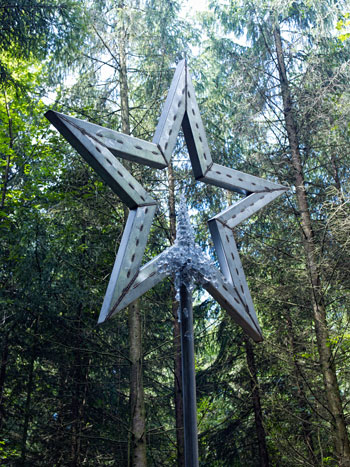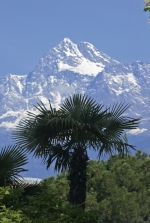I walked off the path at Vent des Forêts, a contemporary art installation in the Meuse
 Vent des Forêts is an intense project, a creative utopia, both realistic and generous.
Vent des Forêts is an intense project, a creative utopia, both realistic and generous.


 A contemporary art installation in an agricultural region in the heart of Lorraine. Close to a hundred works are here to be discovered, on trails that total up to several days worth of walking.
A contemporary art installation in an agricultural region in the heart of Lorraine. Close to a hundred works are here to be discovered, on trails that total up to several days worth of walking.
Amazingly, Vent des Forêts has quietly existed for 16 years, quite a paradox for such a monumental work. Six forest villages lost in five thousand hectares of valleys and forest agreed to let artists work in private orchards, gardens, fields, and clearings, create contemporary sculptures there, and then integrate them into the landscape. I arrived at dawn at the TGV high-speed train station at Bar-le-Duc and the Voie Sacrée road, since it was the only train coming from Paris on Monday morning. I had only the vaguest idea of what I was going to see. I had arranged a meeting on the first floor of the Fresnes-au-Mont town hall, where the bus dropped me after I told the driver where I was going.
A quick exchange with the driver: “If you are stopping at the Fresnes-au-Mont town hall, that means you are going to Vent des Forêts.” Here, Vent des Forêts is part of daily life. People are used to finding a contemporary sculpture on the side of a road or the middle of a field or clearing. A few kilometers from Fresnes-au-Mont, I was hypnotized by the sudden appearance of a car pulling a trailer, both mounted on huge tractor tires, on the side of the road. Even more spectacular was a grass hut sitting on the top of the trailer, like some sort of exotic hat with a palm tree growing out of it. “That’s Vent des Forêts,” the driver told me, as if it were the most normal thing in the world.
The artistic director, Pascal Yonet, met me. “Vent des Forêts is not land art, it’s a rural contemporary art space. The Meuse is a rural region, and we wanted contemporary art to be integrated into its surroundings so that people felt like they were part of it.”
Pascal Yonet, who took over the artistic direction of Vent des Forêts a year ago, speaks about the project with a passion that is contagious: “When the works were set in place in July, the artists stayed with the local inhabitants and realized their work with them. Vent des Forêt’s strength is that it brings these two universes together, planting the roots of contemporary art in a region with an agricultural tradition. Farmers offer their fields, their private orchards, their gardens, as settings for sculptures, totems, installations, and they use their skills to help the artists finalize their works and make them last. For example, for “Obsolete Variables” by Nicolas Boulard (*1), we worked with a blacksmith and the work was placed in a spot recommended by the owner of the land. At first, we wanted to put it at an angle, but the owner said to put it in the middle, where four fields meet, so that you could see it well and it wouldn’t get in the way of farmers coming to work their land. Vent des Forêts is a collective work, where everyone brings their skills, their creativity, and their savoir-faire.
A few brief words with the team to find out which works I was going to see, and if we should put maps of Vent des Forêts along the path and bring trash bags to pick up garbage left behind by walkers. While the minivan vroomed around the curves, Pascal Yonet explained the schedule: “First we will visit the Maisons Sylvestre by Matali Crasset. For the moment, only ‘Le Nichoir’ is finished and it was inaugurated last summer. It’s an experimental project: ecological cabins in the middle of the forest that exist in harmony with nature. There, you sleep, eat, breath, dream, and live another way.”
When we arrive, Pascal Yonet opens the locked door of ‘Le Nichoir’ so we can visit the inside and some hikers, surprised to see the door open, peek inside. They are neighbors who have never visited the cabin. “We’d like to come sleep here, it would be an interesting experience.” Pascal Yonet invites them to reserve a date. “It’s important that the locals take possession of the Maisons Sylvestre; Matali worked on the osmosis between the cabin and the life of the forest, she wants Maisons Sylvestre to insert itself naturally into the life of the local inhabitants. To the right of the access bridge, is a net, like you would find on a catamaran, a huge hammock for relaxing outside and looking out at the landscape.
Maisons Sylvestre by Matali Crasset, located in the heart of Vent des Forêts, are works of art in the middle of the woods.
After a few kilometers, Pascal Yonet parks the minivan near a trail that leads into the forest. A few empty beer cans and cigarette butts lie on the ground, farther on some candy wrappers. Pascal Yonet takes out the garbage bags and starts to pick them up. “This is pretty rare, visitors usually are respectful, as if the chemistry between contemporary art and nature inspired respect and made them think. It’s rare that we find trash around the sculptures.”
We start to head down the steep trail, towards "Salut Pour Tous, Encore des Agapes à Moratoire Orphique" by Théodore Fivel (*2). Suddenly a monumental masque appears in the middle of a clearing, right in front of us. Pascal Yonet inspects the sculpture, and opens the door of the bread oven. “This is great, moss is beginning to grow in the seams of the sculpture. Once they are installed, the sculptures live with nature, this evolution is part of the work. We are going to go back to the road off the trail, I’ll show you an older work.”
Naturally, there are spider webs and brambles. Pascal Yonet continues, relaxed, but walking quickly. “In this forest you often see wild boar, but they are usually afraid of us.” A little unnerved by this news, I asked what we should do if we happen to cross one that is a little more courageous. “Don’t worry, I’ll tell you what to do.”
We get back to the minivan intact, and get in to go eat at Madame Simon’s house. Madame Simon is a character, and her restaurant is the kind you don’t find any more. We are expected: on the menu, vegetables from her garden, eggs from her henhouse, and other local products, just like home. Madame Simon didn’t need to wait for the locavore movement—started in San Francisco in the 2000s and now in France—to start eating and serving organic food.
A few minutes later, a man in a navy blue tank top and his son enter the restaurant, say hi to Pascal Yonet (who knows everyone), and chats about the crops and the sculptures of Vent des Forêts. They sit down and start to eat the contents of their insulated lunch boxes. Madame Simone gives them silverware and asks what else they’d like to eat. “Two fried eggs, if there are any.” She leaves the restaurant and heads to the henhouse a few meters away. She is too busy to serve us, so in the end it’s the farmer himself who will cook the eggs.After an excellent lunch, we leave and pass by a private orchard where totem poles stand guard duty, protecting the plum blossoms. We continue our route towards Fresnes-au-Mont to see one of Vent des Forêts most impressive pieces: the Japanese garden (*3). Surrounded by the branch of a stream, with a view of the village through a space in the trees, the setting is magic. And when the night comes on, around 6pm, a mist comes in from the east, enveloping the visitor in a profound meditation. An initiation
by Isabelle Brigout
(1) Nicolas Boulard has built a cabin with a hail cannon that generates shock waves every 10 minutes and is supposed to turn hailstones to slush.
(2) Théodore Fivel has created an enormous masque whose mouth is an oven where you can bake bread.
(3) Japanese Garden and fog sculpture by Fujiko Nakaya.
Vent des Forêts (leventdesforets.org), Meuse Tourism (www.meusetourism.com)
Luxury hotels and designer Bed and Breakfasts in Alsace Lorraine Business hotels and Secret places













